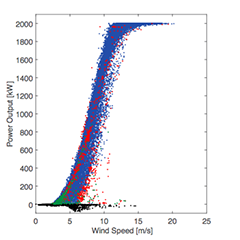Fredrik Larsson, CMO, Breeze explains to PES…
Major failures in wind turbines are often expensive to repair and cause loss of revenue due to long down times. With a downward spiral in electricity prices wind turbine owners and operators have started to focus more on methods to predict failures in order to reduce long downtimes and reactive maintenance.
Analysis of measurements, such as vibration, has been successfully applied for early fault detection in mechanical components like a gearbox. However, these techniques are limited mostly to the rotating mechanical components in the wind turbine. The wind turbine supervisory control and data acquisition system (SCADA) records a large number of measurements which represent the current operating conditions in the wind turbines. An intelligent analysis of these measurements can allow a fault in wind turbine components to be detected well in advance, so that expensive failures can be avoided by planning appropriate maintenance. However, to extract actionable information from the SCADA data is not a straight forward task. Wind turbines operate in highly variable conditions making it difficult to set a baseline behavior pattern, which in turn makes it difficult to detect the points in time when the wind turbine deviates from its normal operation.
The renewable energy intelligence platform Breeze is developing a flexible and accurate tool to use the large amount of SCADA data to obtain actionable information about impending component failures in wind turbines. Development is in the early experimental phases with a target completion date of Q4 2016. To predict failures a mathematical modeling tool called Artificial Neural Networks (ANN) is being used. ANN is powerful method for modeling non-linear real world physical relationships. The ANN models have been proven to work with high accuracy in the Chalmers University of Technology doctorate program and are now being implemented into Breeze.




























